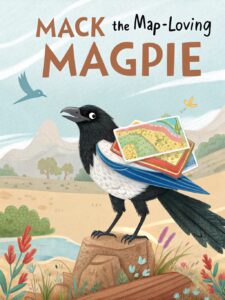
Question More, Action Knowledge.
Remember, at QMAK, we don’t just teach; we empower. We don’t just inform; we inspire. We don’t just question; we act. Become a Gold Member, and let’s unlock your child’s full potential, one question at a time.

High in an old oak tree at the edge of Silverleaf Valley lived Mack, a magpie known for his impressive collection of shiny things. But unlike other magpies who collected coins and bottle caps, Mack collected maps.
Maps of every kind lined his nest – weather maps, migration routes, star charts, and even an old human hiking map he’d found by the lake. Mack spent hours studying them all.
“These maps tell me everything I need to know about the world,” Mack would tell the other birds. “With enough maps, there are no surprises!”
Mack was the leader of the Silverleaf flock, responsible for guiding them south each autumn when the cold winds began to blow. For years, the older birds had taught the flock which landmarks to follow and how to feel the changing air currents. But Mack believed his maps were better than the old ways.
“This year,” Mack announced one September morning, “our migration will be perfectly planned! I’ve studied all the maps and watched the weather reports from the television in the cabin window. I know exactly which route to take and where we’ll stop each night.”
The older birds looked concerned. “Maps are helpful, Mack,” said Iris, the oldest magpie, “but they can’t show everything. The territory is always changing.”
“Nonsense!” Mack chirped confidently. “My maps are detailed and accurate. I’ve even marked where the best berries grow along the way!”
As migration day approached, Mack barely slept. He memorized every detail on his maps, calculated the exact distance they would travel each day, and watched every weather report through the cabin window. He created a precise schedule that would get them to their winter home in exactly twelve days.
When the day arrived, the flock gathered at the edge of the valley. Mack stood proudly at the front, his favorite map tucked safely in his beak.
“Follow me!” he called, spreading his wings and soaring upward. The flock rose behind him, a beautiful swirl of black and white feathers against the blue sky.
For the first day, everything went according to plan. They covered exactly the distance Mack had calculated and settled for the night in the forest he had marked on his map.
“See?” Mack said proudly. “The map shows us everything we need to know!”
But on the second day, things began to change. Dark clouds gathered on the horizon – clouds that weren’t supposed to be there according to the weather report Mack had watched.
“We need to adjust our course,” suggested Iris. “Those clouds mean a storm is coming.”
Mack shook his head. “My map shows clear skies. The weatherman said so! We’ll continue as planned.”
Within hours, heavy rain began to fall. The wind pushed against their wings, making flying difficult. Mack struggled to keep his map dry as he searched for the landmarks he had memorized, but they were hidden by the storm.
“Mack, we need to find shelter!” called Iris over the howling wind. “This storm isn’t on your map, but it’s definitely in our territory!”
Finally, soaked and exhausted, Mack had to admit that his perfect plan wasn’t working. The flock took shelter in a small cave until the storm passed. That night, while the others slept, Mack stared at his soggy, ruined map.
“I don’t understand,” he whispered. “Everything was so clear on the map.”
The next morning, the storm had cleared, but Mack discovered a new problem. The river they needed to follow had changed course since his map was made. A flood had carved a new path through the valley.
“Now what do we do?” asked a young magpie. “Your map says the river goes that way, but it clearly goes this way now.”
Mack felt lost. His confidence was shaken. “I… I don’t know,” he admitted.
Iris gently hopped beside him. “Mack, maps are useful tools, but they’re not the same as the territory itself. Maps can become outdated. They can’t show every detail. And most importantly, they can’t predict how things might change.”
“But without my maps, how will we find our way?” Mack asked.
“We use the maps as guides, not as absolute truth,” Iris explained. “We also need to observe the actual territory around us, feel the air currents, notice which way the trees bend in the wind, and be ready to adapt when reality doesn’t match our expectations.”
As the migration continued, Mack learned to balance what his maps showed with what he actually observed. When a forest on his map had been cut down, the flock found a new place to rest. When unexpected tailwinds gave them extra speed, they adjusted their schedule. When they discovered a new field full of berries not marked on any map, they enjoyed the unexpected feast.
By the time they reached their winter home, Mack had a new appreciation for both maps and territory. That winter, he still collected maps, but he also spent more time observing the world around him – the patterns of clouds, the behavior of other animals, and the subtle changes in the landscape.
When spring came and it was time to migrate back north, Mack gathered the flock.
“I’ve studied the maps,” he told them, holding up his newest collection, “but I know they’re just simplified pictures of a complex world. This time, we’ll use them as guides while paying attention to the actual territory we fly through. Together, we’ll find the best way home.”
As the flock soared into the sky, Mack felt a new kind of confidence – not the rigid certainty of believing his maps were perfect, but the flexible strength that comes from understanding that the map is not the territory, and being ready to adapt when the real world surprises you.
The positive messages include:
The elementary reading level is maintained through simple dialogue, concrete examples, and the relatable character of Mack, making the abstract concept of “the map is not the territory” accessible and engaging for young readers.

Remember, at QMAK, we don’t just teach; we empower. We don’t just inform; we inspire. We don’t just question; we act. Become a Gold Member, and let’s unlock your child’s full potential, one question at a time.